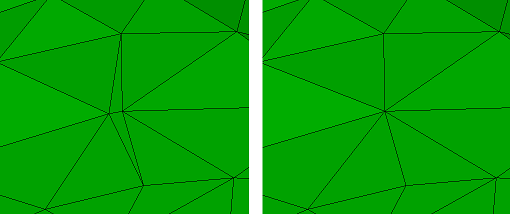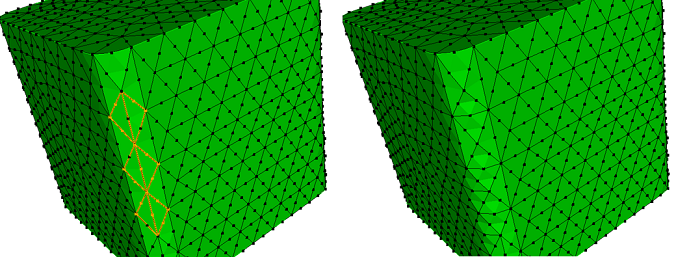
Cubit 15.8 User Documentation
CUBIT currently offers several options for modifying an existing finite element mesh. Triangle and tetrahedral meshes sometimes contain low quality elements that can be removed by the following operations.
The following first two commands collapse triangles, while the third collapses tetrahedra. Collapses are performed only if the collapse operation does not cause worse quality in the surrounding, surviving mesh; otherwise the collapse is not performed. The collapse operation removes the element by consolidating two neighbor nodes of the specified mesh entity into one, to either node location or their midpoint. The specified metric is used to determine quality, the default being Scaled Jacobian.
Collapse Edge <ids> [SCALED JACOBIAN|Aspect Ratio|Shape|Shape and Size]
Collapse Tri <ids> [SCALED JACOBIAN|Aspect Ratio|Shape|Shape and Size]
Collapse Tet <ids> [Altitude|Aspect Ratio|Aspect Ratio Gam|Distortion|Inradius|Jacobian|Normalized Inradius|Node Distance|SCALED JACOBIAN|Shape|Shape and Size|Timestep]

Figure 1. Before and After Triangle/Edge Collapse
The following command collapses triangles containing the given edge, with no regard for quality.
Meshedit Collapse edge <id> [keep node <id>] [compress_ids]
This command only works on triangle surface meshes. If volumetric elements, or quads, are attached to the edge, the command fails. The keep node option control which node to collapse to. The option compress_ids compresses holes in the mesh id space caused by the collapse.
Combining nodes to collapse tetrahedra can be done with the following command. The first node specified is merged into (deleted) the second node. If the first node cannot be moved due to geometry constraints (it's owned by a vertex), the operation fails. This command is behind a developer flag so set dev on must be issued before use.
Merge Node <id> <id>
Cubit offers commands to remove overconstrained tetrahedra - tets containing two triangles on the same surface and all four corner nodes on surfaces, curves, or vertices. These tets are not amenable to smoothing leaving removal as the only viable solution to improve quality.
Remove Overconstrained Tet <ids>
The tets are deleted and the two back sides become surface triangles. If the tets have mid-edge nodes, the back mid-edge nodes are snapped to the surface. If this removal operation generates worse quality (aspect ratio) than in the tet removed, the operation is not performed. Figure 2 shows before and after image of removing overconstrained tets.

Figure 2. Before and After Removing Overconstrained Tets